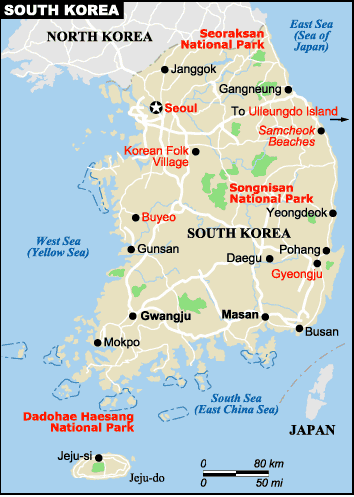| Official Name | Republic of Korea |
| Capital | Seoul |
| Area | 98,488 Sq Km (38,026 Sq Mi) |
| Location | South Korea is located on the southern part of the Korean Peninsula in East Asia. |
| Geography | It is bound by North Korea to the north, the Yellow Sea to the west, the Sea of Japan to the east as well as the Korea and Cheju Straits to the south. |
| Population | (2002) | (2015) |
| 46,584,500 | 51,069,000 | |
| Density | (1991) | (2015) |
| 436 persons per sq km | 518.5 persons per sq km | |
| (1,129 persons per sq mi) | (1,343 persons per sq mi) | |
| Urban-Rural | (1990) | |
| 74.4% urban | ||
| 25.6% rural | ||
| Sex Distribution | (1990) | (2015) |
| 50.4% male | 50.1% male (25,609,000) | |
| 49.6% female | 49.9% female (25,461,000) | |
| Life Expectancy at Birth | (1990) | |
| 67.4 years male | ||
| 75.4 years female | ||
| Age Breakdown | (1990) | (2015) |
| 27% under 15 | 13.9% under 15 (6,907,000) | |
| 31% 15 to 29 | 72.9% 15 to 64 (36,230,000) | |
| 21% 30 and 44 | 13.2% 65 and over (6,569,000) | |
| 13% 45 and 59 | ||
| 6% 60 and 74 | ||
| 2% 75 and over | ||
| Birth Rate | (1990) | (2015) |
| 15.6 per 1,000 | 8.6 per 1,000 | |
| Death Rate | (1990) | (2015) |
| 5.8 per 1,000 | 14.1 per 1,000 | |
| Increase Rate | (1990) | (2015) |
| 9.8 per 1,000 | -5.5 per 1,000 | |
| Infant Mortality Rate | (2003) | (2015) |
| 15.0 per 1,000 live births | 2.7 per 1,000 live births |
Insomnia
Method
A representative sample of the South Korean general population composed of 3719 noninstitutionalized individuals aged 15 years or older were interviewed by telephone using the Sleep-EVAL system.
The participation rate was 91.4%. The interviews covered:
- sleep habits,
- sleep symptomatology,
- physical and psychiatric illnesses.
DSM-IV sleep and psychiatric disorder diagnoses were also assessed.
Results
Insomnia symptoms occurring at least three nights per week were reported by 17.0% of the sample:
- Difficulty initiating sleep (DIS) was mentioned by 4.0% of the sample.
- Difficulty maintaining sleep (DMS) by 11.5%.
- Early morning awakenings (EMA) by 1.8%.
- Nonrestorative sleep (NRS) by 4.7% of the sample.
DSM-IV insomnia disorder diagnoses were found in 5% of the sample. Over 50% of subjects with insomnia symptoms reported important daytime consequences. Another 20% reported mild or moderate consequences.
However, the proportion of insomnia subjects seeking medical help for their sleep problems was very low (6.8%).
Conclusions
As in Western countries, insomnia is widespread in South Korea, affecting nearly one in five individuals. Many of them would benefit from medical help; however, few insomnia subjects are consulting for this problem. An educational effort is needed for both the general population and the physicians.
REFERENCES
- Ohayon MM, Hong SC. Prevalence of insomnia and associated factors in South Korea. J Psychosom Res 2002 Jul;53(1):593-600

